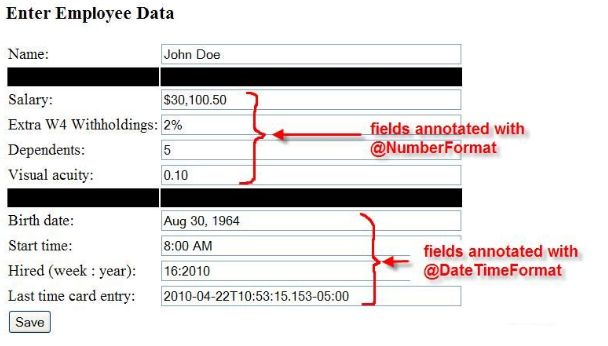Spring中的用于格式化的annotation
在2009年,Spring Framework 3.0发布了,带来了很多新的功能强大的特性。 除了支持RESTful Web service的Spring Expression Language(SpEL)等主要功能外,还有一些很方便的,而且不需要太多时间学习的新的特性。这里我们介绍其中的一个:用于格式化的注解。
简介
Spring 3 提供了两个可以用于格式化数字、日期和时间的注解@NumberFormat和@DateTimeFormat,这两个标签可以用于bean的属性或方法参数上。@NumberFormat可以用来格式化任何的数字的基本类型(如int,long)或java.lang.Number的实例(如 BigDecimal, Integer)。@DateTimeFormat可以用来格式化java.util.Date、java.util.Calendar和 java.util.Long类型,也可以用于Joda Time类型的字段或参数。(Joda Time是一个开源的包,提供了对date和time类的一些替代类)。
要指定数字或日期/时间类型的属性,只需要在其上添加 @NumberFormat或@DateTimeFormat注解接可以了。例如下面的代码:
import java.math.BigDecimal;
import java.util.Calendar;
import java.util.Date;
import org.joda.time.LocalTime;
public class Employee {
private String name;
private double salary;
private double w4AdditionalWithdraw;
private int dependents;
private BigDecimal visualAcuity;
private Date birthDate;
private Calendar hireDate;
private LocalTime startTime;
private long lastTimeEntry;
/**
* initialization block to provide sample data for display
*/
{
this.name = "John Doe";
this.salary = 30100.50;
this.w4AdditionalWithdraw = 0.02;
this.dependents = 5;
this.visualAcuity = new BigDecimal(".1");
Calendar dob = Calendar.getInstance();
dob.set(1964, Calendar.AUGUST, 30);
this.birthDate = dob.getTime();
this.hireDate = Calendar.getInstance();
this.startTime = new LocalTime(8, 0);
this.lastTimeEntry = (new Date()).getTime() - 10000;
}
public String getName() {
return name;
}
public void setName(String name) {
this.name = name;
}
public double getSalary() {
return salary;
}
public void setSalary(double salary) {
this.salary = salary;
}
public double getW4AdditionalWithdraw() {
return w4AdditionalWithdraw;
}
public void setW4AdditionalWithdraw(double w4AdditionalWithdraw) {
this.w4AdditionalWithdraw = w4AdditionalWithdraw;
}
public int getDependents() {
return dependents;
}
public void setDependents(int dependents) {
this.dependents = dependents;
}
public BigDecimal getVisualAcuity() {
return visualAcuity;
}
public void setVisualAcuity(BigDecimal visualAcuity) {
this.visualAcuity = visualAcuity;
}
public Date getBirthDate() {
return birthDate;
}
public void setBirthDate(Date birthDate) {
this.birthDate = birthDate;
}
public LocalTime getStartTime() {
return startTime;
}
public void setStartTime(LocalTime startTime) {
this.startTime = startTime;
}
public Calendar getHireDate() {
return hireDate;
}
public void setHireDate(Calendar hireDate) {
this.hireDate = hireDate;
}
public long getLastTimeEntry() {
return lastTimeEntry;
}
public void setLastTimeEntry(long lastTimeEntry) {
this.lastTimeEntry = lastTimeEntry;
}
}
这段代码中我们没有添加注解。如果我们使用Spring 份额Form 标签将这个bean中的数据用于显示的时候,我们会得到类似下图的结果:
可以看到,所有的数据都是以默认的格式显示的,Spring会使用默认的格式将数据显示在HTML表格中(其他的框架也大多如此)。如果想显示特殊的格式,开发人员必须编写特殊的getter/setter方法或使用PropertyEditors来显示特殊格式的数字或者日期/时间。
现在有了 @NumberFormat和@DateTimeFormat注解,我们可以使用这两个注解来完成同样的功能。如下面的代码所示:
import java.math.BigDecimal;
import java.util.Calendar;
import java.util.Date;
import org.joda.time.LocalTime;
import org.springframework.format.annotation.DateTimeFormat;
import org.springframework.format.annotation.NumberFormat;
import org.springframework.format.annotation.DateTimeFormat.ISO;
import org.springframework.format.annotation.NumberFormat.Style;
public class Employee {
private String name;
/**
* numeric fields using @NumberFormat annotation for formatting.
*/
@NumberFormat(style = Style.CURRENCY)
private double salary;
@NumberFormat(style = Style.PERCENT)
private double w4AdditionalWithdraw;
@NumberFormat
private int dependents;
@NumberFormat(pattern = "0.00")
private BigDecimal visualAcuity;
/**
* date and time fields using @DateTimeFormat annotation for formatting.
*/
@DateTimeFormat(style = "M-")
private Date birthDate;
@DateTimeFormat(pattern = "w:yyyy")
private Calendar hireDate;
@DateTimeFormat(style = "-S")
private LocalTime startTime;
@DateTimeFormat(iso = ISO.DATE_TIME)
private long lastTimeEntry;
/**
* initialization block to provide sample data for display
*/
{
this.name = "John Doe";
this.salary = 30100.50;
this.w4AdditionalWithdraw = 0.02;
this.dependents = 5;
this.visualAcuity = new BigDecimal(".1");
Calendar dob = Calendar.getInstance();
dob.set(1964, Calendar.AUGUST, 30);
this.birthDate = dob.getTime();
this.hireDate = Calendar.getInstance();
this.startTime = new LocalTime(8, 0);
this.lastTimeEntry = (new Date()).getTime() - 10000;
}
public String getName() {
return name;
}
public void setName(String name) {
this.name = name;
}
public double getSalary() {
return salary;
}
public void setSalary(double salary) {
this.salary = salary;
}
public double getW4AdditionalWithdraw() {
return w4AdditionalWithdraw;
}
public void setW4AdditionalWithdraw(double w4AdditionalWithdraw) {
this.w4AdditionalWithdraw = w4AdditionalWithdraw;
}
public int getDependents() {
return dependents;
}
public void setDependents(int dependents) {
this.dependents = dependents;
}
public BigDecimal getVisualAcuity() {
return visualAcuity;
}
public void setVisualAcuity(BigDecimal visualAcuity) {
this.visualAcuity = visualAcuity;
}
public Date getBirthDate() {
return birthDate;
}
public void setBirthDate(Date birthDate) {
this.birthDate = birthDate;
}
public LocalTime getStartTime() {
return startTime;
}
public void setStartTime(LocalTime startTime) {
this.startTime = startTime;
}
public Calendar getHireDate() {
return hireDate;
}
public void setHireDate(Calendar hireDate) {
this.hireDate = hireDate;
}
public long getLastTimeEntry() {
return lastTimeEntry;
}
public void setLastTimeEntry(long lastTimeEntry) {
this.lastTimeEntry = lastTimeEntry;
}
}
当在页面上显示的时候,我们会直接得到我们想要的格式,如下图所示:
注解的可选属性
注解的属性决定了@NumberFormat和@DateTimeFormat注解怎样格式化相应的属性。 @NumberFormat注解有两个可选的属性:style和pattern。style属性是一个NumberFormat.Style枚举值,可以是以下的三个值之一:
注解的可选属性
注解的属性决定了@NumberFormat和@DateTimeFormat注解怎样格式化相应的属性。 @NumberFormat注解有两个可选的属性:style和pattern。style属性是一个NumberFormat.Style枚举值,可以 是以下的三个值之一:
| NumberFormat.Style 枚举值 |
是否缺省值 |
| NUMBER | 是 |
| CURRENCY | 否 |
| PERCENT | 否 |
这 3种style的应用我们在上面的代码中都有相应的例子。
具体的style的表现形式是与区域相关的。例如,一个double类型的字段,如果style是CURRENCY,那么在en-us的区域显示的时候前面会加上$,在zh-cn的区域显示的时候前面会加上¥。
如果以上的3中方式无法满足需求,我们可以使用pattern属性来指定特殊的输出格式。Pattern的值要遵循Java标准的numeric formatting pattern。对于@NumberFormat来说缺省的是没有pattern的。
@DateTimeFormat 注解有3个可选的属性:style,pattern和iso。属性style允许我们使用两个字符的字符串来表明怎样格式化日期和时间。第一个字符表明了 日期的格式,第二个字符表明了时间的格式。下面的表格中列出了可用的选择以及相应的输出的例子:
| 描述 | 字符串值 | 示例输出 |
| 短格式(这是缺省值) | SS |
8/30/64 11:24 AM |
| 中等格式 | MM | Aug 30, 1964 11:24:41 AM |
| 长格式 | LL |
August 30, 1964 11:24:41 AM CDT |
| 完整格式 | FF | Sunday, August 30, 1964 11:24:41 AM CDT |
| 使用短横线省略日期或时间 | M- | Aug 30, 1964 |
Pattern 属性允许我们使用自定义的日期/时间格式。该属性的值遵循java标准的date/time格式规范。缺省的该属性的值为空,也就是不进行特殊的格式化。
最后,可以使用org.springframework.format.annotation.DateTimeFormat.ISO枚举值来使用ISO标准的日期/时间格式来格式化。下面的表格中列出了可能的值和相应的输出
| ISO枚举值 |
输出 |
| DATE | 2000-10-31 |
| TIME | 01:30:00.000-05:00(最后的是时区) |
| DATE_TIME | 2000-10-31 01:30:00.000-05:00. |
| NONE | 不进行ISO标准的格式化 |
使用格式化注解的设置
要使用上面介绍的格式化注解,需要进行如下的配置:
1.下载Spring 3.0的jar包并加入到类路径中。
2. 将下面的配置信息加入到spring bean的XML配置文件中。
解析参数
我们也可以使用这些注解来告诉Spring怎样解析输入的数据。下面的例子显示了怎样使用@DateTimeFormat来解析以ISO格式输入的时间信息:
public String getEmployeesOnTheClock(@DateTimeFormat(iso=ISO.TIME) java.util.Date time) { ... }